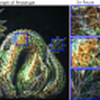Microsoft shows a thing or two how digital holography can be used to build novel near-eye displays for virtual and mixed (or augmented) reality. Using the form factor of sunglasses by using a powerful wave-front correction ability.
They address some of the known limitations of digital holograms and demonstrate how holography can add powerful, new features to near-eye displays: per-pixel focus control, vision correction, and unpresented combinations of form factor and field of view. See the technical paper and video for limitations, additional details, and a description of future work.
Digital holograms are often associated with noisy, low contrast, low resolution, and mono color imagery. We demonstrate how high contrast,high resolution, and full color digital holograms can be formed using existing hardware devices, yielding images that more closely match the quality of conventional displays. The following images are photographs taken of a prototype holographic near-eye display. The field of view is 70 degrees horizontally. Due to the complex required calculations, digital holograms are also often associated with slow, off-line calculations. We propose the use of eye tracked approximate holograms that have correct image focus and best image quality where the user is looking. Combined with GPU-accelerated algorithms, we demonstrate real-time hologram generation at rates of 90-260 Hz on a desktop GPU (NVIDIA GeForce GTX 980 TI).
Microsoft Researches Holographic Near-Eye Displays


